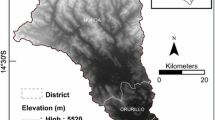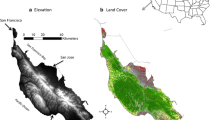Abstract
We used the Normalized Difference Vegetation Index (NDVI) in the rapidly growing Puget Sound region over three 5-year time blocks between 1986–1999 at three spatial scales in 42 Watershed Administrative Units (WAUs) to assess changes in the amounts and patterns of green vegetation. On average, approximately 20% of the area in each WAU experienced significant NDVI change over each 5-year time block. Cumulative NDVI change over 15 years (summing change over each 5-year time block) was an average of approximately 60% of each WAU, but was as high as 100% in some. At the regional scale, seasonal weather patterns and green-up from logging were the primary drivers of observed increases in NDVI values. At the WAU scale, anthropogenic factors were important drivers of both positive and negative NDVI change. For example, population density was highly correlated with negative NDVI change over 15 years (r = 0.66, P < 0.01), as was road density (r = 0.71, P < 0.01). At the smallest scale (within 3 case study WAUs) land use differences such as preserving versus harvesting forest lands drove vegetation change. We conclude that large areas within most watersheds are continually and heavily impacted by the high levels of human use and development over short time periods. Our results indicate that varying patterns and processes can be detected at multiple scales using changes in NDVIa values.
Similar content being viewed by others
References
Alberti, M., Weeks, R. and Coe, S.: 2004, ‘Urban land cover change analysis for the Central Puget Sound’, J. Photogrammetry Remote Sens. 70, 1043–1052.
Arnold, C. L. and Gibbons, C. J.: 1996, ‘Impervious surface coverage: Emergence of a key environmental indicator,’ JAMA 62, 243–258.
Berk, A., Bernstein, L. S. and Robertson, D. C.: 1989, MODTRAN: A Moderate Resolution Model for LOWTRAN 7, Report No. GL-TR-89-0122, Geophysics Lab, Bedford, MA.
Bolton, S. and Watts, A.: 1998, Results from Forest Hydrology Studies: Is There a Lesson for Urban Planners? Salmon in the City Conference, Seattle, WA.
Booth, D. B. and Jackson, C. J.: 1997, ‘Urbanization of aquatic systems – Degradation thresholds, stormwater detention, and the limits of mitigation,’ Water Resourc. Bull. 33, 1077–1090.
Chavez, P. J.: 1988, ‘An improved dark-object subtraction technique for atmospheric scattering correction of multispectral data,’ Remote Sens. Environ. 24, 459–479.
Coppin, P. and Bauer, M.: 1996, ‘Digital change detection in forest ecosystems with remote sensing imagery,’ Remote Sens. Rev. 13, 207–234.
Cohen, A. W.: 2002, Integrating Science and Policy: A Case Study of the Best Available Science Amendment to the Washington State Growth Management Act, and Vegetative Land Cover Change in the Greater Puget Sound Area: 1986–1999, M.S. Thesis, Department of Urban Planning, University of Washington, Seattle, WA.
Dale, V. H., Brown, S., Haeuber, R. A., Hobbs, N. T., Huntly, N., Naiman, R. J., Riebsame, W. E., Turner, M. G. and Valone, T. J.: 2000, ‘Ecological principles and guidelines for managing the use of land,’ Ecol. Appl. 10, 639–670.
Davenport, M. L. and Nicholson, S. E.: 1993, ‘On the relation between rainfall and the Normalized Difference Vegetation Index for diverse vegetation types in East Africa,’ Int. J. Remote Sens. 14, 2369–2389.
Deering, D. W., Rouse, J. W., Jr., Haas, R. H. and Schell, J. A.: 1975, ‘Measuring Forage Production of Grazing Units from Landsat MSS Data,’ in Proceedings of the 10th International Symposium on Remote Sensing of Environment, Ann Arbor, MI.
Finlayson, D. P., Haugerud, R. and Greenberg, R.: 2001, Building a Seamless Digital Elevation Model of the Puget Sound Basin, Puget Sound Regional Research 2001, Report by the Puget Sound Water Quality Action Team, Olympia, WA.
Franklin, J. F. and Dyrness, C. T.: 1988, Natural Vegetation of Washington and Oregon, Oregon State University Press, Corvallis, Oregon.
Furby, S. L.: 2001, ‘Calibrating images from different dates to ‘like-value’ digital counts,’ Remote Sens. Environ. 77, 186–196.
Grove, J. M. and Burch, W. R., Jr.: 1997, ‘A social ecology approach and application of urban ecosystem and landscape analysis: A case study of Baltimore Maryland,’ Urban Ecosys. 1, 259–275.
Horner, R. R. and May, C. W.: 1998, Watershed Urbanization and the Decline of Salmon in Puget Sound Streams. Salmon in the City Conference, Seattle, WA.
Lillesand, T. M. and Kiefer, R. W.: 2000, Remote Sensing and Image Interpretation, Wiley, New York.
Lyon, J. G., Yuan, D., Lunetta, R. S. and Elvidge, C. D.: 1998, ‘A change detection experiment using Vegetation Indices,’ Photogrammetric Eng. Remote Sens. 64, 143–150.
Machlis, G. E., Force, J. E. and Burch, W. R., Jr.: 1997, ‘The human ecosystem part 1: The human ecosystem as an organizing concept in ecosystem management,’ Soc. Nat. Resourc. 10, 347–367.
Marzluff, J. M. and Ewing, K.: 2001, ‘Restoration of fragmented andscapes for the conservation of birds: A general framework and specific recommendations for urbanizing landscapes,’ Restor. Ecol. 9, 280–292.
Mas, J. F.: 1999, ‘Monitoring land-cover changes: A comparison of change detection techniques,’ Int. J. Remote Sens. 20, 139–152.
Mather, P.: 1987, Computer Processing of Remotely-Sensed Images: An Introduction, Wiley, New York.
May, C., Horner, R., Karr, J. R., Mar, B. W. and Welch, E. B.: 2002, ‘The cumulative effects of urbanization on small streams in the Puget Sound Lowland Ecoregion,’ Watershed Protection Tech. 2, 483–494.
McDonnell, M. J., Pickett, S. T. A. and Pouyat, R. V.: 1993, ‘Application of the Ecological Gradient Paradigm to the Study of Urban Effects,’ in: M. J. McDonnell and S. T. A. Pickett (eds.), Humans as Components of Ecosystems, Springer-Verlag, New York, pp. 175–189.
Minor, T. B., Lancaster, J., Wade, T. G., Wickham, J. D., Whitford, W. and Jones, K. B.: 1999, ‘Evaluating change in rangeland condition using multitemporal AVHRR data and Geographic Information System Analysis,’ Environ. Monit. Assess. 59, 211–223.
Mucher, C. A., Steinnocher, K. T., Kressler, F. P. and Heunks, C.: 2000, ‘Land cover characterization and change detection for environmental monitoring of pan-Europe,’ Int. J. Remote Sens. 21, 1159–1181.
Murphy, M.: 1998, Washington's Dynamic Forests: A Study of Forests and Forest Issues. League of Women Voters of Washington Education Fund, Seattle, WA.
Naiman, R. J., Decamps, H. and Pollock, M.: 1993, ‘The role of Riparian Corridors in maintaining regional biodiversity,’ Ecol. Appl. 3, 209–212.
Nelson, R. F.: 1983, Detecting forest canopy change due to insect activity using Landsat MSS,’ Photogrammetric Eng. Remote Sens. 10, 1243–1251.
Nemani, R., Pierce, L. and Running, S.: 1993, ‘Forest ecosystem processes at the watershed scale: Sensitivity to remotely-sensed Leaf Area Index estimates,’ Int. J. Remote Sens. 14, 2519–2534.
Noaa: 2001, Climatological Data, World Data Center for Meteorology, Asheville, National Climatic Data Center, Asheville, NC.
Owen, T. W., Carlson, T. N. and Gillies, R. R.: 1998, ‘An assessment of satellite remotely-sensed land cover parameters in quantitatively describing the climatic effect of urbanization,’ Int. J. Remote Sens. 19, 1663–1681.
Pickett, S. T. A., Burch, W. R., Jr., Dalton, S. E., Foresman, T. W., Grove, J. M. and Rowantree, R. A.: 1997, ‘A conceptual framework for the study of human ecosystems in urban areas,’ Urban Ecosys. 1, 185–201.
Pickett, S. T. A. and Rogers, K. H.: 1997, ‘Patch dynamics: The Transformation of Landscape Structure and Function,’ in: J. A. Bissonnette (ed.), Wildlife and Landscape Ecology, Springer-Verlag, New York, pp. 101–127.
Puget Sound Regional Council: 2001, Decennial Change in Population and Land Area of Cities, Towns, and Counties in the Central Puget Sound: 1990 to 2000, Census 2000.
Schueler, T.: 1994, ‘The importance of imperviousness,’ Watershed Prot. Tech. 1, 100–111.
Singh, A.: 1989, ‘Digital change detection techniques using remotely sensed data,’ Int. J. Remote Sens. 10, 989–1003.
Stefanov, W. L.: 2001, ‘Monitoring urban land cover change: An expert system approach to land cover classification of semiarid to urban centers,’ Remote Sens. Environ. 77, 173–185.
Townsend, J. R. G., Justice, C. O., Gurney, C. and McManus, J.: 1992, ‘The impact of misregistration on change detection,’ IEEE Trans. Geosci. Remote Sens. 30, 1054–1060.
U.S. Census Bureau, Geography Division: 2000, Census Tract Census 2000 TIGER/Line Files, Department of Commerce, Washington, DC.
UN: 2002, World Urbanization Prospects: The 2001 Revision, United Nations.
USGS: 1999, Landsat-7 Level-0 and Level-1 Data Sets Document, National Oceanic and Atmospheric Administration NOAA, NOAA/National Environmental Satellite, Data, and Information Service, and NASA.
Vitousek, P. M., 1994, ‘Beyond global warming: Ecology and global change,’ Ecology 75, 1861–1876.
Waddell, P. and Alberti, M.: 2000, ‘Integrated Simulation of Real Estate Development and Land Cover Change,’ in: Proceedings of the 4th International Conference on Integrating Geographic Information Systems GIS and Environmental Modeling, Banff, Canada.
Wu, J.: 1999, ‘Hierarchy and scaling: Extrapolating information along a scaling ladder,’ Can. J. Remote Sens. 25, 367–380.
Wu, J. and Loucks, O. L.: 1995, ‘From balance of nature to hierarchical patch dynamics: A paradigm shift in ecology,’ Quart. Rev. Biol. 70, 439–466.
Yuan, D. and Elvidge, C. D.: 1998, ‘NALC land cover change detection pilot study: Washington D.C. area experiments,’ Remote Sens. Environ. 66, 166–178.
ZAR, J. H.: 1996, Biostatistical Analysis, Simon & Schuster/A Viacom Company, Upper Saddle River, NJ.
Author information
Authors and Affiliations
Corresponding author
Rights and permissions
About this article
Cite this article
Morawitz, D.F., Blewett, T.M., Cohen, A. et al. Using NDVI to Assess Vegetative Land Cover Change in Central Puget Sound. Environ Monit Assess 114, 85–106 (2006). https://doi.org/10.1007/s10661-006-1679-z
Received:
Accepted:
Published:
Issue Date:
DOI: https://doi.org/10.1007/s10661-006-1679-z




